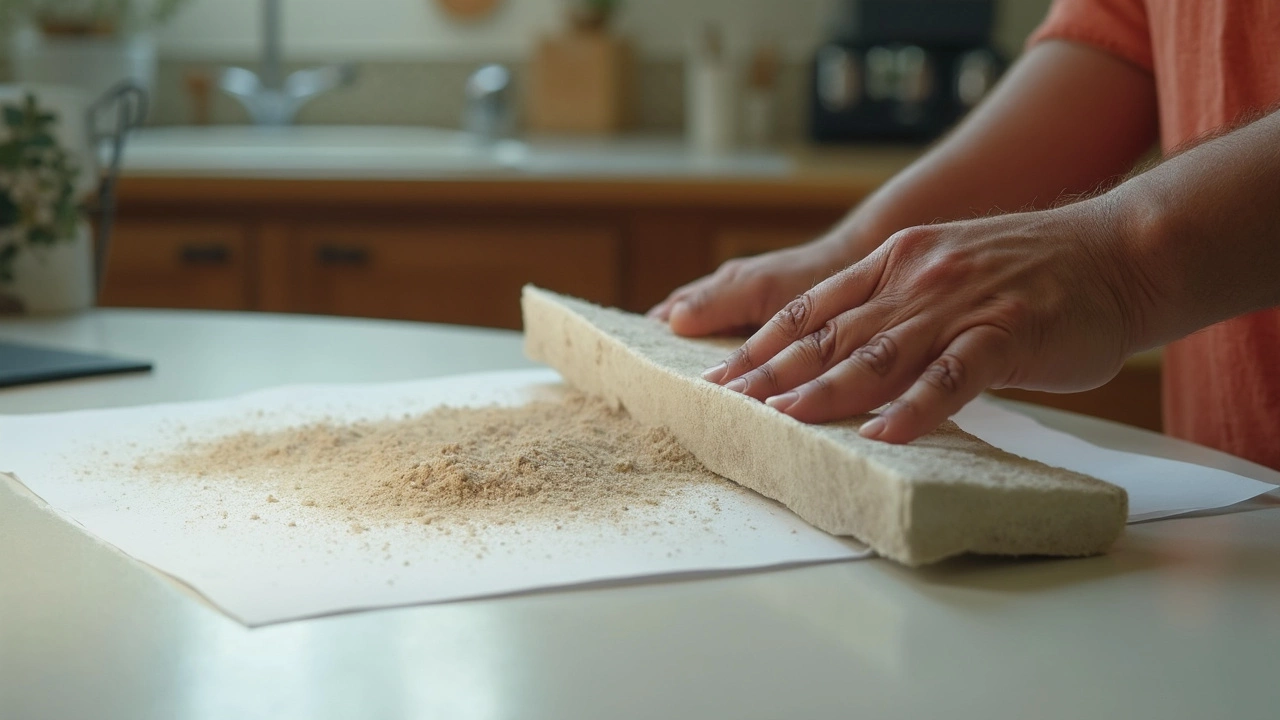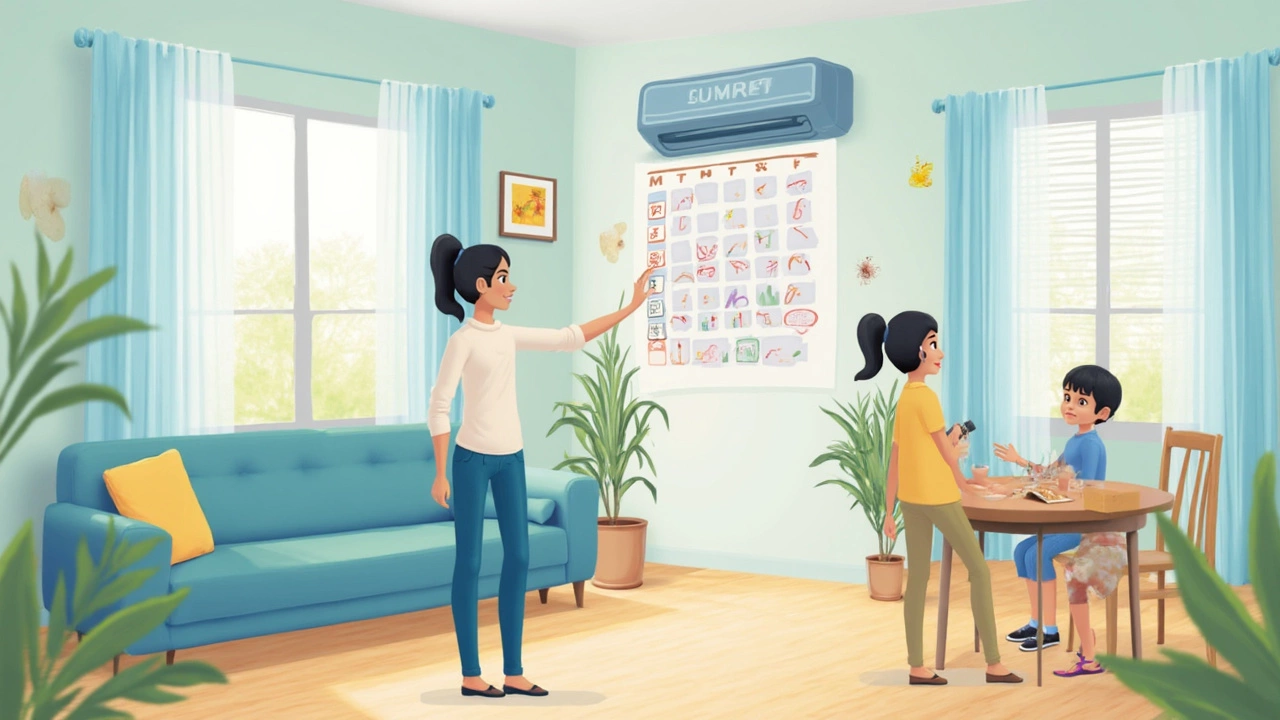How to Test Your Air Filter: Easy Steps for Cleaner Air
 Jun, 3 2025
Jun, 3 2025
Ever wonder if that dusty air filter in your vent is really doing anything, or if it's just sitting there collecting fuzz? Checking your air filter is one of those jobs most folks ignore until the sneezing starts or the AC starts wheezing. But testing it is quick, easy, and actually saves you money on energy bills and doctor trips. Plus, a fresh filter really keeps your house feeling less stuffy and helps folks with allergies breathe easier.
Before reaching for your toolbox, all you need is your eyes and maybe a white paper towel for a simple trick. The fastest way to spot a problem is just looking for dirt, dust, or a gray patch covering the filter’s surface. If light barely passes through or you can see visible gunk, it’s choking up. Even newish filters can surprise you after a pollen-heavy week or if you’ve had pets shedding nonstop.
- Why Test Your Air Filter?
- Simple Visual Checks Anyone Can Do
- The White Towel Test & Other Easy Tricks
- Spotting Signs You Need a Replacement
- Keeping Your Air Clean Year-Round
Why Test Your Air Filter?
If you’ve ever noticed your house smells musty, your allergies act up, or your HVAC bill jumps for no reason, your air filter is probably at the center of it all. Filters keep dust, pollen, pet hair, and even mold spores from circling through your air. Without a solid filter, that junk just keeps moving around your home every time you run the furnace or AC.
Here’s the kicker: the U.S. Department of Energy says that a clogged filter can spike your energy use by up to 15%. That’s straight-up money escaping from your wallet, just because the filter’s choked with gunk. On top of wasted cash, dirty filters make your heating and cooling system work harder, which means parts wear out faster and break sooner. Nobody wants to pay for surprise repairs when you could avoid them with a quick filter check.
There’s also the health side. The American Lung Association points out that indoor air is often 2 to 5 times more polluted than outside air. Breathing all that trapped pollen, dust, or mold can be a nightmare for folks with asthma or allergies. Filters help trap these, but only if they’re clean and working right.
| Reason to Test | What’s at Stake |
|---|---|
| Energy Efficiency | Up to 15% higher bills with clogging |
| Air Quality | Less dust and allergens in each breath |
| System Life | HVAC lasts longer with less strain |
| Health | Fewer asthma and allergy flare-ups |
So, if you want to breathe easier, keep bills manageable, and avoid random breakdowns, it just makes sense to check your filter now and then. It only takes a minute and could save a lot of headaches down the line.
Simple Visual Checks Anyone Can Do
You don't need any gadgets or special skills to figure out if your air filter needs attention. A lot of times, your eyes can tell you more than any fancy tool. Start by popping off the cover or sliding out your filter (remember to turn off your HVAC system for safety). Hold it up to a light source, like a lamp or even your phone flashlight.
If you struggle to see light coming through, that's a red flag. The filter should look nearly white or light gray if it's still usable. Here’s a quick way to size up your filter:
- Is the surface totally gray, brown, or covered in dust and lint?
- See clumps of hair or dirt? Time for a new filter.
- Notice a musty or burnt smell right by the filter? That’s a sign it’s overdue for a swap.
- If bits of the filter are torn, warped, or sagging, throw it out—it's past its prime.
Most home experts say that in normal conditions, the average filter lasts about three months. However, having pets, construction, or lots of foot traffic can cut that time in half. Check out this quick-reference table so you know when to step in early:
| Household Factor | Typical Filter Life |
|---|---|
| No pets, no allergies | Every 3 months |
| One pet or mild allergies | Every 2 months |
| Multiple pets or heavy allergies | Every 1 month |
| Renovation/construction dust | Check monthly |
Don’t forget to date your filter whenever you change it. A cheap marker or even a sticky note right on the frame works great. That way, next time you pull it out, you’ll know exactly how long it’s been in service, no guessing needed.

The White Towel Test & Other Easy Tricks
You really don’t need fancy gadgets to figure out if your air filter still works. The white towel test is simple and actually works. Here’s how you do it: grab a clean white towel, put your system on, and hold the towel up next to the vent. If the towel quickly gathers any gray dust, your filter isn’t catching what it should anymore. That’s a strong sign it’s time for a swap.
Another way is the flashlight test. Pull out your air filter, hold a flashlight (or even your phone’s flashlight) on one side, and look from the other. If barely any light gets through, that filter is packed with dust and needs to go. Most new filters are pretty easy to see through when clean. If it looks like an old coffee filter after a long brew, it’s not working right.
If you want something a little different, try flicking the filter gently over a clean surface. A pile of dust on the table means your filter is full. And if you’re not freaked out by what you find, check for any musty smells coming from the filter. If it smells weird or moldy, don’t mess around—replace it right away.
By the way, a clogged filter will make your AC or heater work overtime, which shows up as higher energy bills. If you’re seeing more dust around the house or family allergies are flaring up, your filter probably isn’t handling the load. These at-home tricks are quicker (and cheaper) than buying an air quality tester or calling a pro. Most people who check regularly end up changing their filters more often and have fewer issues with their HVAC systems.
Spotting Signs You Need a Replacement
It’s wild how fast an air filter can clog up—especially if you have pets, smokers, or live somewhere dusty. Skipping a filter change can tank your air quality and even damage your HVAC system. But a lot of folks aren’t sure how to spot the red flags before things get bad. Here are the real signs yours is overdue for a swap.
- Gray or brown color: If your filter’s no longer white or off-white, it’s doing its job and catching dirt. But if it’s solid gray or brown, it’s maxed out.
- Dust kicked up in your home: You wipe surfaces, but dust comes back fast. Clogged filters don’t trap particles, so they float around instead.
- Odd smells from the vents: A musty or dirty sock smell coming from the vents means old debris or even mold has set in.
- Visible pet hair or clumps: Pet owners will spot thick layers clinging to the mesh—time to change it out.
- Increased allergy symptoms: Sneezing, itchy eyes, and stuffy noses can all flare up when airflow is blocked and allergens aren't trapped anymore.
- Sudden spike in your energy bill: A dirty filter makes your air system work overtime, burning more power for the same effect.
If you want numbers, check out how often filters usually need a change:
| Home Type | Filter Change Frequency |
|---|---|
| Single occupant, no pets/allergies | Every 90 days |
| Family home, no pets | Every 60 days |
| With 1 pet | Every 45 days |
| Multiple pets/allergies | Every 30 days |
Some folks wait for the HVAC to blow weakly or even begin rumbling—but by then, you’re running up your power bill or risking bigger repairs. If you’re seeing these signs, don’t put off changing that filter. It’s one of the cheapest fixes for a lot of sneaky home problems.

Keeping Your Air Clean Year-Round
Keeping your house air fresh isn’t a one-and-done deal. Filters trap dust, pollen, pet hair, and all the little bits you don't want to breathe, but they lose steam fast if you let them sit too long. Swapping out your air filter every 1-3 months is what most HVAC pros recommend—especially if you have pets, allergies, or live in a busy city. If you keep forgetting, mark it in your calendar or set a phone reminder to stay ahead of it.
Don't stop with just the air filter, though. Vacuuming rugs, dusting vents, and sealing drafty windows can all boost your filter’s work and cut down what ends up in your lungs. For folks running air purifiers, remember their filters need love too—most need cleaning or replacing about every 3-6 months.
- If you’re changing your filter and it looks dark or has a coat of fuzz, don’t wait. Swap it right away.
- Get the right size filter—using the wrong one lets dust sneak around, not through, the filter.
- Write the date on your new filter before you install it, so there’s no guessing next time.
- Don’t forget to check filters before allergy or wildfire seasons start; a clean one can actually help you breathe easier when the air outside is rough.
Ever wonder how much gunk a filter catches? Even a cheapo one can snatch up 80% of big dust and pet dander. The pricier HEPA-style filters can trap up to 99.97% of tiny particles—right down to the size of pollen, mold spores, and some bacteria.
| Filter Type | Average Lifespan | Particles Removed |
|---|---|---|
| Fiberglass (Basic) | 30 days | 60-80% |
| Pleated (Standard) | 60-90 days | 80-95% |
| HEPA | 6-12 months | 99.97% |
By paying attention to your air filter and a few other basics, you make your home a way nicer—and healthier—place to live. Don’t wait for weird smells or a sneezing fit to remind you. Stay ahead of the dust; your lungs will thank you.